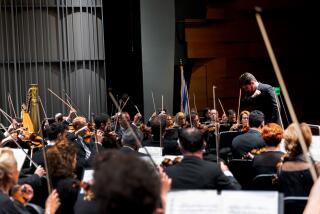Review: iPalpiti dazzles in a superb ‘Stabat Mater’ at Disney Hall
- Share via
Led by conductor Eduard Schmieder, iPalpiti, the dazzling international chamber orchestra of mostly young professional string players, gets better and more ambitious every year. The ensemble gave its annual gala at Walt Disney Concert Hall on Saturday night, and for the first time in its 17-year history, two singers joined them.
The occasion was Pergolesi’s 1736 spiritual masterpiece, “Stabat Mater,” composed at the end of his short life (he died at age 26, probably of tuberculosis), and the superb soloists were Icelandic soprano Dísella Lárusdóttir and American countertenor Daniel Bubeck.
The text of the piece comes from a 13th-century Franciscan monk who imagined the Passion from the point of view of a mother’s grief at the loss of a child. It was banned by the Church for its all-too-worldly emotionalism, but a personal approach clearly attracted Pergolesi.
Schmieder, who first conducted the score in Israel three years ago, gave a reading all the more moving for its tasteful restraint, guiding his ensemble to a near-perfect balance of contemporary sound with Baroque clarity of articulation.
More overtly operatic than Bubeck, Lárusdóttir’s long lament gathered cumulative power without sacrificing Pergolesi’s moving directness of expression. Bubeck’s resourceful countertenor voice encompassed the earthly and other-worldly, offering subtle character and contrast in his duets with Lárusdóttir.
The sacred turned to the profane after intermission. The iPalpiti women wore red flowers in their hair; the men sported red neckerchiefs. And Schmieder wore a smile-generating crimson brocade jacket for “singing” of an instrumental sort in Rodion Shchedrin’s wittily scored, dramatic and warmly lyrical 1967 arrangement of themes from Georges Bizet’s opera “Carmen,” for strings and percussion.
Shchedrin’s suite, composed in 1967 for his wife, ballerina Maya Plisetskaya, was taken on a thrilling ride by iPalpiti, with the addition of a timpanist and four percussionists negotiating the sensitive acoustics of Disney Hall with color and finely calibrated power.
Schmieder opened the program with two mood-setting works: a movement from C.P.E. Bach’s “Hamburg” Sinfonia in A, and the aria from pater J.S. Bach’s Overture in D, both showing the ensemble’s breathtaking precision and dynamic control, which carried through in the two encores: a short collage of themes from “Carmen” arranged by Schmieder himself, and the rondo from Mozart’s Divertimento, K.136.
Between encores, Schmieder told the audience how Shchedrin’s “Carmen” Suite, which would go on to become one of his most popular scores, was initially banned by the Soviet minister of culture until Shostakovich stepped in.
A former refusenik in the then-Soviet Union who studied with Shostakovich, Schmieder knows a thing or two about censorship and political oppression. His comments seemed to ask why are institutions and bureaucracies so afraid of art? One answer: Art represents freedom, and it’s harder to control people’s emotions. Schmieder’s art, as exemplified by the preceding concert, was all about communicating emotional energy through glorious sound.
More to Read
The biggest entertainment stories
Get our big stories about Hollywood, film, television, music, arts, culture and more right in your inbox as soon as they publish.
You may occasionally receive promotional content from the Los Angeles Times.










